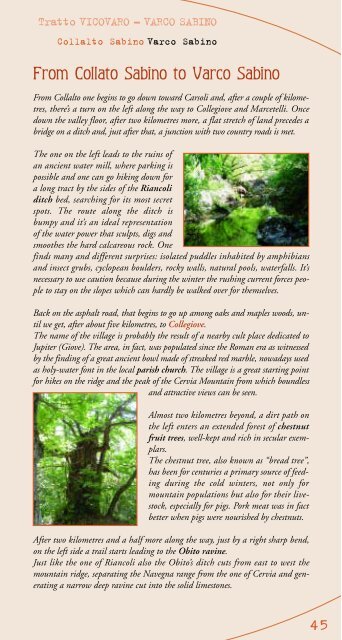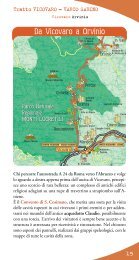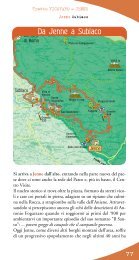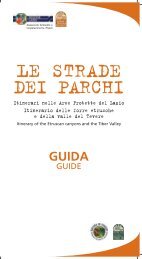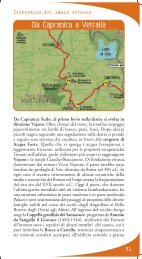LE STRADE DEI PARCHI - Naturainviaggio.It
LE STRADE DEI PARCHI - Naturainviaggio.It
LE STRADE DEI PARCHI - Naturainviaggio.It
Create successful ePaper yourself
Turn your PDF publications into a flip-book with our unique Google optimized e-Paper software.
Tratto VICOVARO - VARCO SABINO<br />
Collalto Sabino Varco Sabino<br />
From Collato Sabino to Varco Sabino<br />
From Collalto one begins to go down toward Carsoli and, after a couple of kilometres,<br />
there’s a turn on the left along the way to Collegiove and Marcetelli. Once<br />
down the valley floor, after two kilometres more, a flat stretch of land precedes a<br />
bridge on a ditch and, just after that, a junction with two country roads is met.<br />
The one on the left leads to the ruins of<br />
an ancient water mill, where parking is<br />
possible and one can go hiking down for<br />
a long tract by the sides of the Riancoli<br />
ditch bed, searching for its most secret<br />
spots. The route along the ditch is<br />
bumpy and it’s an ideal representation<br />
of the water power that sculpts, digs and<br />
smoothes the hard calcareous rock. One<br />
finds many and different surprises: isolated puddles inhabited by amphibians<br />
and insect grubs, cyclopean boulders, rocky walls, natural pools, waterfalls. <strong>It</strong>’s<br />
necessary to use caution because during the winter the rushing current forces people<br />
to stay on the slopes which can hardly be walked over for themselves.<br />
Back on the asphalt road, that begins to go up among oaks and maples woods, until<br />
we get, after about five kilometres, to Collegiove.<br />
The name of the village is probably the result of a nearby cult place dedicated to<br />
Jupiter (Giove). The area, in fact, was populated since the Roman era as witnessed<br />
by the finding of a great ancient bowl made of streaked red marble, nowadays used<br />
as holy-water font in the local parish church. The village is a great starting point<br />
for hikes on the ridge and the peak of the Cervia Mountain from which boundless<br />
and attractive views can be seen.<br />
Almost two kilometres beyond, a dirt path on<br />
the left enters an extended forest of chestnut<br />
fruit trees, well-kept and rich in secular exemplars.<br />
The chestnut tree, also known as “bread tree”,<br />
has been for centuries a primary source of feeding<br />
during the cold winters, not only for<br />
mountain populations but also for their livestock,<br />
especially for pigs. Pork meat was in fact<br />
better when pigs were nourished by chestnuts.<br />
After two kilometres and a half more along the way, just by a right sharp bend,<br />
on the left side a trail starts leading to the Obito ravine.<br />
Just like the one of Riancoli also the Obito’s ditch cuts from east to west the<br />
mountain ridge, separating the Navegna range from the one of Cervia and generating<br />
a narrow deep ravine cut into the solid limestones.<br />
45


